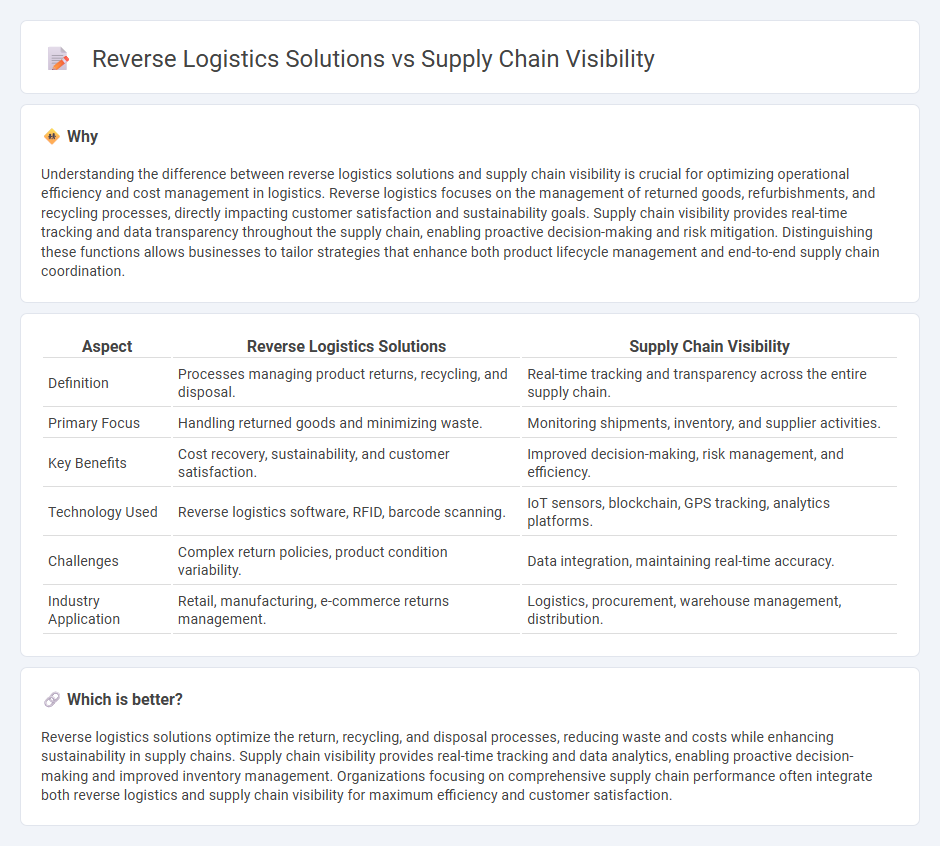
Reverse logistics solutions streamline the process of managing product returns, refurbishments, and recycling, reducing costs and improving sustainability. Supply chain visibility enhances real-time tracking and transparency of goods from origin to destination, optimizing inventory management and customer satisfaction. Explore how integrating reverse logistics with advanced visibility tools can transform your supply chain efficiency.
Why it is important
Understanding the difference between reverse logistics solutions and supply chain visibility is crucial for optimizing operational efficiency and cost management in logistics. Reverse logistics focuses on the management of returned goods, refurbishments, and recycling processes, directly impacting customer satisfaction and sustainability goals. Supply chain visibility provides real-time tracking and data transparency throughout the supply chain, enabling proactive decision-making and risk mitigation. Distinguishing these functions allows businesses to tailor strategies that enhance both product lifecycle management and end-to-end supply chain coordination.
Comparison Table
| Aspect | Reverse Logistics Solutions | Supply Chain Visibility |
|---|---|---|
| Definition | Processes managing product returns, recycling, and disposal. | Real-time tracking and transparency across the entire supply chain. |
| Primary Focus | Handling returned goods and minimizing waste. | Monitoring shipments, inventory, and supplier activities. |
| Key Benefits | Cost recovery, sustainability, and customer satisfaction. | Improved decision-making, risk management, and efficiency. |
| Technology Used | Reverse logistics software, RFID, barcode scanning. | IoT sensors, blockchain, GPS tracking, analytics platforms. |
| Challenges | Complex return policies, product condition variability. | Data integration, maintaining real-time accuracy. |
| Industry Application | Retail, manufacturing, e-commerce returns management. | Logistics, procurement, warehouse management, distribution. |
Which is better?
Reverse logistics solutions optimize the return, recycling, and disposal processes, reducing waste and costs while enhancing sustainability in supply chains. Supply chain visibility provides real-time tracking and data analytics, enabling proactive decision-making and improved inventory management. Organizations focusing on comprehensive supply chain performance often integrate both reverse logistics and supply chain visibility for maximum efficiency and customer satisfaction.
Connection
Reverse logistics solutions enhance supply chain visibility by enabling real-time tracking of returned products and materials throughout the return process. Improved transparency in reverse logistics helps identify inefficiencies, reduce waste, and optimize resource allocation within the entire supply chain. Integrating advanced technologies like RFID and IoT further strengthens visibility, ensuring better decision-making and streamlined returns management.
Key Terms
**Supply Chain Visibility:**
Supply chain visibility enables real-time tracking and monitoring of goods, improving inventory management, reducing delays, and enhancing overall operational efficiency. Advanced technologies like IoT sensors, RFID, and blockchain facilitate transparent data sharing across all stakeholders, leading to proactive issue resolution and optimized decision-making. Explore comprehensive supply chain visibility solutions to transform your logistics operations.
Real-time Tracking
Real-time tracking enhances supply chain visibility by providing continuous updates on shipment locations, inventory status, and delivery timelines, thereby improving operational efficiency and reducing delays. In reverse logistics, real-time tracking facilitates the timely retrieval and processing of returned goods, optimizing reverse flow management and minimizing losses. Explore how integrating advanced tracking technologies can transform both supply chain visibility and reverse logistics solutions.
Data Integration
Supply chain visibility enhances operational efficiency by integrating real-time data from multiple sources, enabling proactive decision-making in inventory management and demand forecasting. Reverse logistics solutions rely heavily on data integration to track product returns, optimize reverse flows, and ensure effective asset recovery. Explore how advanced data integration drives innovation in supply chain and reverse logistics systems.
Source and External Links
What is Supply Chain Visibility? Meaning and Definition - GEP - Supply chain visibility is the ability to track inventory as it moves through the supply chain in real time, enabling end-to-end transparency to optimize inventory, coordination, risk management, and accountability.
What is Supply Chain Visibility? - Tibco - Supply chain visibility tracks a product from raw materials through manufacturing to customer delivery, providing unified, transparent access to data across all supply chain steps to improve efficiency and customer satisfaction.
What Is Supply Chain Visibility (SCV)? Definition & Examples - NetSuite - A highly visible supply chain enables tracking of components and products through all stages, allowing businesses to monitor supplier and shipment status, respond quickly to issues, and maintain accurate inventory and certifications.
 dowidth.com
dowidth.com